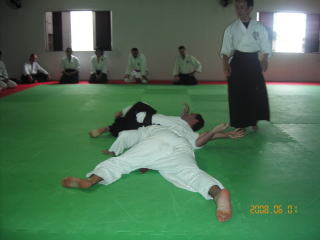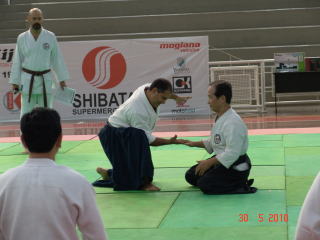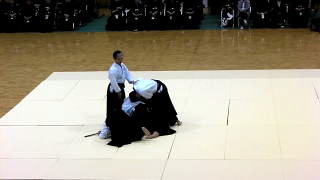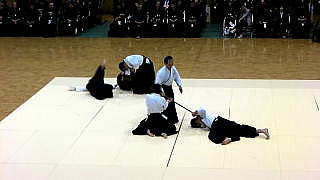|
Aiki Demonstration

2008-6-1 (Brazil/SaoPaulo) 
.jpg)
2010-5-18 (Brazil/SaoPaulo)
[Ⅰ] About Aiki Skill 15 April 2015
Aiki is just a word. I think that we should accept this word not some name
of martial arts, but as name of some skills. In Japan, there are
several ancient martial arts that are following traditional skills and
forms. Perhaps Aiki will be one of them, besides we will recognize
that it is a non-competitive skill.
After the Second
World War, as far as I know, GM Morihei Ueshiba created Aikido
by using Aiki skill of Daito-Ryu Aiki Jujitsu and other martial arts.
Aiki skill is comprised of small and subtle motions, therefore from that
time, the private lesson seems to have been common practice. But since that
present time mass training has become the mainstream, and the type of skill
has changed too. Now big motions that are easy to see are the norm. I
think that Aikido is composed of these two types. When I showed Aiki to my
Taiwanese friend 15 years ago, he was surprised and said, “it’s a skill of
Neigong” At that time, I completely didn’t know the meaning of Neigong. I
remember that I answered soon, “This is Aiki, not Neigong.” But it
seems that Aiki exists in the category of Neigong in the Chinese block.
With the skill of Aiki, the practitioner must assimilate themselves, into
the opponent, and at the same time incorporate the opponent as one
part of their being. When you push or pull the opponent, you have to
touch the surface of the opponent, namely the skin. It seems that the
movements are rubbing or scooping against the part of the opponent. If
the body is one of unity, the movement of pushing or pulling against
the body will properly cause reactions. Decreasing these reactions may
be a caracteristic of Aiki; especially in the movement of up and down the
important thing is to understand and use gravity. It is very difficult to
explain about Aiki, but if we experience Aiki, the difference is very
clear. The important thing is to keep our body in a usual shape, and to
remake our body like a heavy rope by doing training. Besides, when we do training,
grab the floor by the feet and keep the axis of the body, and then perhaps
we will be able to create Aiki with our movements, we and the opponent
already will have been blending. This feeling is difficult to happen from
the competition style. Aiki is the skill of not crushing each other but
blending each other.
On the other
hand, it seems to include phenomena of frozen skill too. Aiki skill
is not supernatural, it's only to sharpen our own usual power and refine
our sense by blending to the opponent. A big person should get Aiki of a
big person; a small person should get Aiki of a small person. This Aiki
ought to happen in other martial arts too; but it’s too small to notice. I
feel that Aiki is not just the monopoly of Aikido.
Japan Medical Kendo Federation
At the Kyoto Budo-Center
2015-4-11 The 50th time
Kendo Meeting 

|


.jpg)





.jpg)
.jpg)